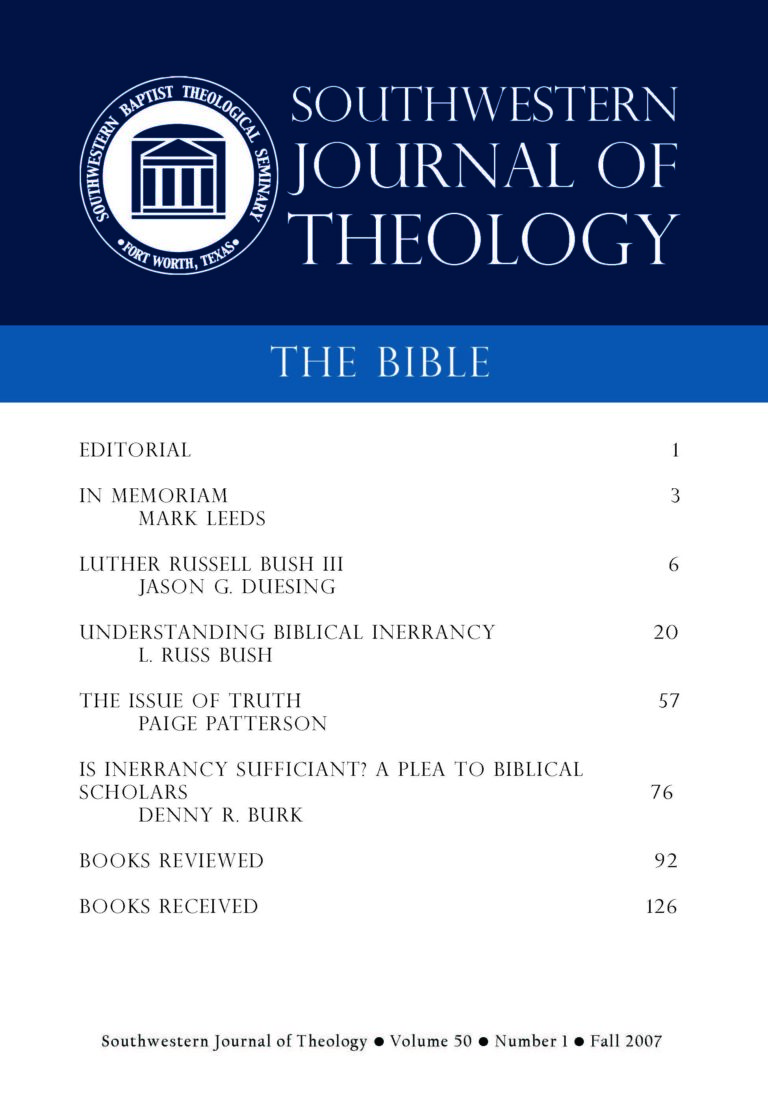
The Bible
Southwestern Journal of Theology
Volume 50, No. 1 – Fall 2007
Managing Editor: Malcolm B. Yarnell III
By B.H. Carroll. New York: Fleming H. Revell Company, 1930. Reprint, Volume 1 of the Southwestern Library of Centennial Classics, Fort Worth, 2008. 122 pages. Hardcover, $100.00 for set.
In celebrating the Centennial of Southwestern Seminary it is quite appropriate that a selection of the Seminary’s classic works should begin with a volume by B.H. Carroll. Not only founder of Southwestern Baptist Theological Seminary in 1908, he was also a scholar, professor and a pastor. In the prefaces to his book Inspiration of the Bible, Carroll is lauded as one of the greats of his time, having earned commendations from both George W. Truett and L.R. Scarborough. As a Bible professor for many years at Waco and at Southwestern he, in both the pulpit and the classroom, taught the truths of the Bible which he believed to be inerrant, infallible, and in- spired. As indicated by the title, the last of these is the discussion he takes up in this present work.
Before a summary is given of the work itself, one should note some of the arguments Carroll was combating when he wrote this book. The ideas of evolution, higher criticism, and neo-orthodoxy all attacked, in their own way, the verbal inspiration of Scripture. In defense of the Bible he cherished, he penned this book to clarify for the academy and the churches alike that the Bible, God’s Holy Word, is in fact inspired.
Carroll sets the work in an inclusio of the article from the New Hampshire Confession of Faith on the Holy Scriptures, “We believe that the Holy Bible was written by men divinely inspired,” (15, 122), thus set- ting the tone for the entirety of the work. The first chapter, “Inspiration of the Scriptures as Believed by Baptists,” begins his defense for believing in inspiration from the Bible itself, citing such passages as Hebrews 4:12 and II 2 Timothy 3:16–17. Here he also launches an attack against a neo- orthodox view of the Word calling it “fool-talk” (20).
Chapter two is concerned with looking at the arguments of the higher critics declaring that for the first time the attack on the Bible has come from within the church rather than from “heathens” or “infidels” (28). Seeing these scholars claiming to be working from science, he calls them into question as mere speculatives who daily offer different opinions. After showing their error, he buttresses his argument with more Scripture and gives a formal definition for inspiration (37).
Chapter three begins a series of chapters that look at the method of inspiration more in depth, citing seven examples of God “inspiring” or breathing out upon something. In chapter four he looks at Luke’s account of the gospel and indicates how Luke itself is inspired, closing the chapter by contrasting the exposition of Spurgeon, who lead many men to repentance, against the higher critics, who led few.
Chapter five is concerned with analyzing the method a bit more closely by citing examples of the text where evil men or beasts spoke. Car- roll claims that in each of these instances the participants were used by the Spirit, but were not themselves inspired, Caiaphas being an example. Furthermore, he emphasizes that the Spirit does inspire words, but not in a pure dictation. The Spirit inspires men to write words according to their own style.
Chapter six looks to further difficulties in the text, especially as it seeks to differentiate between illumination and illustration. Chapter seven takes, arguably one of the most difficult books of the Bible, Daniel, and demonstrates how it too is a product of inspiration rather than a later composed myth. Finally, the last chapter not only summarizes the thesis thus far but also addresses the issue of science and the Bible concluding that the two, when one looks at science rightly, are in complete harmony with one another.
Carroll’s work is short and simple enough for the average layman to read, yet its simplicity does not jeopardize its depth of subject matter. Throughout the book one can find allusions to Greek, Hebrew, and Latin, which demonstrate Carroll’s scholarship, as well as illustrative sayings that resonate with the masses at large, demonstrating his desire to be connected to the churches and not only the academy. This work not only establishes a concise view of inspiration in the Bible, but gives a glance at the historic Baptist pastor theologian who founded and prolonged the tradition of Southern Baptists.





